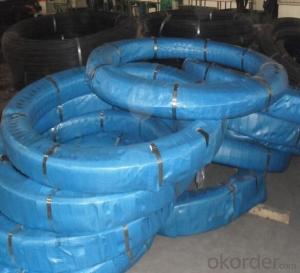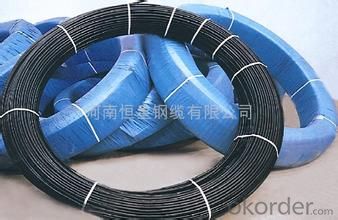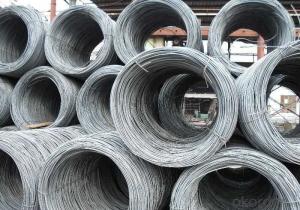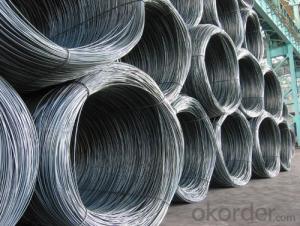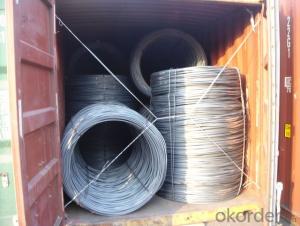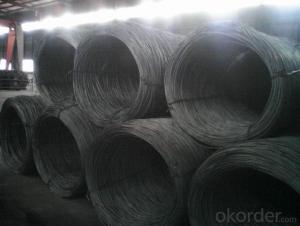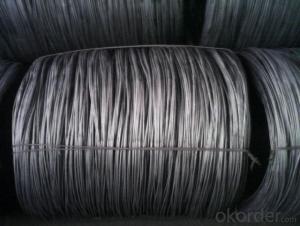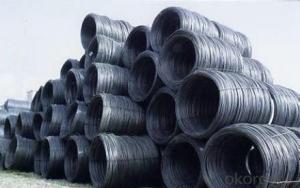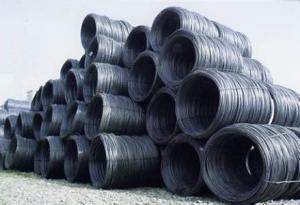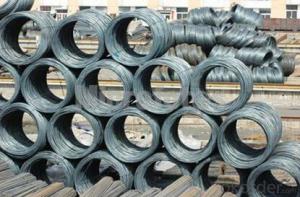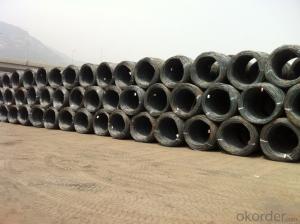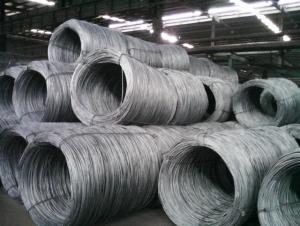Prestressed Hot Rolled Steel Wire
- Loading Port:
- China Main Port
- Payment Terms:
- TT or LC
- Min Order Qty:
- 25-30 m.t.
- Supply Capability:
- -
OKorder Service Pledge
OKorder Financial Service
You Might Also Like
Packaging & Delivery
| Packaging Detail:steel strand coil to be packed in damp proof materials strapped with 8 bands on one wooded pallet with an outer layer of plastic used for anti-rainshower 2 or 3 wooden block undermeath each coil. |
|
| Delivery Detail:within 2 weeks |
Specifications
high carbon class A steel wire
Constructon:7 steel wire
material:wire 82B
FAQ of Prestressed steel wire:
①How is the quality of your products?
Our products are manufactured strictly according to national and internaional standard. If you want see our quality certifications and all kinds of testing report, please just ask us for it.
Guaranteed: If products’ quality don’t accord to discription as we give or the promise before you place order, we promise 100% refund.
②How about price?
Yes, we are factory and be able to give you lowest price below market one, and we have a policy that “ for saving time and absolutely honest business attitude, we quote as lowest as possible for any customer, and discount can be given according to quantity”,if you like bargain and factory price is not low enough as you think, just don’t waste your time.Please trust the quotation we would give you, it is professional one.
③Why should you chose us?
Chose happens because of quality, then price, We can give you both.Additionally, we can also offer professional products inquiry, products knowledge train(for agents), smooth goods delivery, exellent customer solution proposals.Our service formula: good quality+good price+good service=customer’s trust
SGS test is available, customer inspection before shipping is welcome, third party inspection is no problem.
Prestressed Steel Wire Images

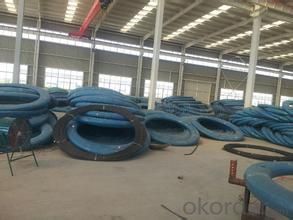
- Q: What are the main factors influencing the choice of steel wire rod order frequency?
- The frequency at which companies place orders for steel wire rods is influenced by several key factors. Firstly, demand and market conditions play a significant role. If there is a high demand for steel wire rods in the market, companies may need to place more frequent orders to meet customer requirements and maintain inventory levels. Additionally, market conditions such as price fluctuations and supply availability can also impact the order frequency. Secondly, the production capacity of the steel wire rod supplier and the lead time required for delivery can affect the order frequency. If a supplier has limited production capacity or a longer lead time, companies may need to place larger and less frequent orders to ensure a continuous supply. Thirdly, inventory management is another factor to consider. Existing inventory levels and storage capacity can influence the order frequency. If a company has limited storage space or wants to minimize inventory holding costs, they may choose to place more frequent orders in smaller quantities. Cost considerations also come into play. The cost of steel wire rods, including the purchase price, transportation, and any applicable taxes or duties, is a significant factor. Companies may analyze the cost of holding inventory versus the cost of frequent ordering to determine the most cost-effective approach. Lastly, the relationship between the company and the steel wire rod supplier can impact the order frequency. A strong and reliable partnership allows for more flexibility in adjusting the order frequency based on changing market conditions or business needs. In conclusion, the choice of steel wire rod order frequency is influenced by demand and market conditions, production capacity and lead time, inventory management, cost considerations, and supplier relationships. Companies must consider these factors to ensure a steady and efficient supply of steel wire rods.
- Q: How is the decarburization of steel wire rod evaluated?
- Various methods and techniques are employed to evaluate the decarburization of steel wire rod, ensuring the final product's quality and properties. Visual inspection is a common evaluation method, whereby the wire rod's surface is carefully examined for signs of decarburization, such as discoloration or scaling. This preliminary assessment offers insights into the level of decarburization. Chemical analysis is also conducted to determine the carbon content at different depths of the wire rod. Samples are taken from various sections of the wire rod and subjected to carbon analysis tests. The results of this analysis reveal the extent of decarburization and aid in assessing its impact on the steel wire rod's mechanical properties. Microscopic examination is a crucial evaluation technique. Metallographic analysis involves preparing thin sections of the wire rod and observing them under a microscope. This allows for a detailed examination of the microstructure, facilitating the identification of any areas affected by decarburization. Specialized equipment, such as image analysis software, can be used to measure the depth and severity of decarburization. Moreover, mechanical testing is performed to evaluate the impact of decarburization on the wire rod's mechanical properties. Tensile strength, hardness, and ductility tests are commonly conducted to assess the wire rod's overall strength and behavior under different conditions. Any significant deviation from the desired mechanical properties may indicate a higher level of decarburization. In conclusion, the evaluation of decarburization in steel wire rod involves a combination of visual inspection, chemical analysis, microscopic examination, and mechanical testing. These techniques provide a comprehensive understanding of the extent and impact of decarburization, ensuring that the wire rod meets the required quality standards and specifications.
- Q: How is steel wire rod used in the manufacturing of wire for medical implants?
- Steel wire rod is an essential raw material used in the manufacturing of wire for medical implants. It serves as the base material from which the wire is produced. Steel wire rod is carefully selected for its high strength, corrosion resistance, and biocompatibility properties. It undergoes a series of processes including drawing, annealing, and surface treatments to transform it into fine wire suitable for medical applications. This wire is then utilized in the fabrication of various medical implants such as surgical sutures, stents, orthopedic devices, and pacemaker leads, providing strength, flexibility, and durability to these life-saving medical products.
- Q: What are the common production processes for molybdenum-coated steel wire rod?
- The common production processes for molybdenum-coated steel wire rod include cleaning and surface preparation, coating deposition through methods like electroplating or thermal spraying, and final finishing processes such as annealing and coating thickness control.
- Q: How is steel wire rod used in the production of wire ropes for elevators?
- Steel wire rod is an essential element utilized in the manufacturing of wire ropes utilized in elevators. These wire ropes are carefully designed to ensure strength, durability, and safety. The steel wire rod acts as the primary material for the production of these ropes. Throughout the production procedure, the steel wire rod undergoes multiple stages in order to convert it into wire ropes for elevators. Initially, the rod is thoroughly cleaned and inspected to guarantee its quality. Subsequently, it is heated and passed through a sequence of dies to gradually decrease its diameter. This drawing process aids in enhancing the wire's strength and flexibility. Following the drawing process, the wire is subjected to galvanization to provide protection against corrosion. This involves applying a layer of zinc onto the wire, which effectively prevents rust and corrosion, thereby ensuring the longevity of the wire ropes. Once the wire has been galvanized, it is twisted and braided into strands. These strands are then combined and twisted together to form the final wire rope. The number of strands and the direction of the twist may vary according to the specific requirements of the elevator application. The resultant wire rope, derived from steel wire rod, possesses exceptional strength and flexibility, rendering it suitable for supporting heavy loads and enduring constant movement. It offers stability and safety, enabling elevators to operate reliably and efficiently. In conclusion, steel wire rod plays a crucial role in the production of wire ropes for elevators. Through various processes such as drawing and galvanization, the wire rod is transformed into robust and long-lasting wire ropes capable of withstanding the demanding conditions of elevator operations.
- Q: What are the challenges faced by the steel wire rod manufacturers?
- Some challenges faced by steel wire rod manufacturers include fluctuating raw material prices, intense competition in the market, stringent quality standards and regulations, the need for continuous innovation and technological advancements, and the impact of global economic factors on demand and pricing.
- Q: What are the main steel wire rod import and export markets?
- Depending on the country and region, the main markets for importing and exporting steel wire rod vary. However, China, the United States, Japan, Germany, South Korea, and Russia are key players in the global steel wire rod trade. China, being the largest producer and consumer of steel wire rod, has a significant presence in the export market. It exports steel wire rod to various destinations, including Southeast Asian countries, the United States, and Europe. The United States is also a major player in the steel wire rod market. It imports substantial amounts of steel wire rod from Canada, Mexico, and Brazil. Additionally, the United States exports steel wire rod to Canada and Mexico. Japan, known for its high-quality steel products, both imports and exports steel wire rod. It primarily imports steel wire rod from South Korea, China, and Taiwan, while its main export destinations include Southeast Asian countries and the United States. Germany is a significant market for steel wire rod in Europe. It mainly imports steel wire rod from Russia, Turkey, and Ukraine. Germany also exports steel wire rod to neighboring European countries. South Korea is a major exporter of steel wire rod, primarily to Vietnam, Malaysia, and the United States. It also imports steel wire rod from China, Japan, and Russia. Lastly, Russia plays an important role in the steel wire rod market as both an exporter and importer. It exports steel wire rod to various countries, including Germany, Italy, and Turkey. Russia also imports steel wire rod from South Korea and China. In conclusion, these countries dominate the global steel wire rod import and export markets, each with its own unique position and trade partnerships. However, it is important to note that the steel industry is dynamic, and market conditions can change over time, affecting import and export dynamics.
- Q: How is steel wire rod used in the manufacturing of wire mesh fences?
- Steel wire rod is used in the manufacturing of wire mesh fences as it serves as the primary raw material. The wire rod is first drawn into thinner wires, which are then woven or welded together to form the mesh pattern of the fence. The strength and durability of the steel wire rod ensures that the resulting wire mesh fence is resilient, able to withstand external forces, and provides security and containment.
- Q: What are the common applications of low carbon steel wire rod?
- Low carbon steel wire rod has a wide range of applications due to its various beneficial properties. Some of the common applications of low carbon steel wire rod include: 1. Construction: Low carbon steel wire rod is widely used in the construction industry for various purposes. It is commonly used for reinforcing concrete structures such as beams, columns, and slabs. The high tensile strength and ductility of low carbon steel wire rod make it an ideal choice for reinforcing purposes. 2. Manufacturing: Low carbon steel wire rod is extensively used in manufacturing industries for the production of various products. It is commonly used for manufacturing nails, screws, bolts, and other fasteners due to its excellent formability and strength. Additionally, it is used in the production of wire mesh, wire ropes, and cables. 3. Automotive industry: Low carbon steel wire rod finds applications in the automotive industry as well. It is used for manufacturing parts such as springs, suspension systems, and tire cords. The flexibility, strength, and durability of low carbon steel wire rod make it suitable for these applications. 4. Agriculture: In the agricultural sector, low carbon steel wire rod is commonly used for constructing fences and wire mesh. It provides durability and strength to the fencing systems, ensuring the security of livestock and crops. Additionally, it is used for making trellises and support structures for plants. 5. Household applications: Low carbon steel wire rod is also used in various household applications. It is used for making hangers, racks, and shelves due to its ability to withstand heavy loads. Additionally, it is used for manufacturing kitchen utensils, wire baskets, and other household items. Overall, low carbon steel wire rod is a versatile material used in numerous industries and applications. Its properties such as formability, strength, and durability make it a preferred choice for various manufacturing and construction purposes.
- Q: What are the standard impact strength requirements for steel wire rod?
- The impact strength requirements of steel wire rod can differ based on the specific application and industry standards. However, in general, steel wire rod needs to have good impact strength properties to ensure durability and resistance against breakage in dynamic loading situations. Various international standards organizations like ASTM International, ISO, and national standards bodies establish the impact strength requirements. These standards offer guidelines for determining the impact strength of steel wire rod through standardized testing methods. To fulfill the standard impact strength requirements, steel wire rod is often subjected to impact tests such as Charpy or Izod tests. These tests involve striking a notched sample of the wire rod with a pendulum hammer and measuring the energy absorbed during fracture. The results provide an indication of the material's ability to endure sudden shock or impact. The specific impact strength requirements for steel wire rod can differ based on factors such as the intended application, industry regulations, and customer specifications. For instance, wire rod used in construction may have different impact strength requirements compared to wire rod used in automotive manufacturing. In summary, the impact strength requirements for steel wire rod are determined by international and national standards organizations and can vary depending on the application. Complying with these requirements ensures that the wire rod possesses the necessary strength and resilience to withstand impact and dynamic loading conditions.
Send your message to us
Prestressed Hot Rolled Steel Wire
- Loading Port:
- China Main Port
- Payment Terms:
- TT or LC
- Min Order Qty:
- 25-30 m.t.
- Supply Capability:
- -
OKorder Service Pledge
OKorder Financial Service
Similar products
Hot products
Hot Searches
Related keywords
